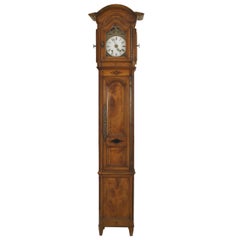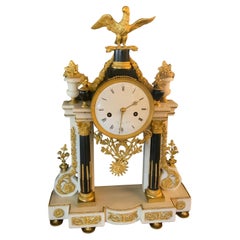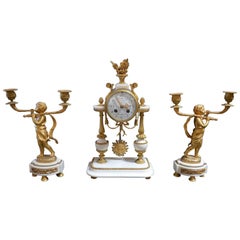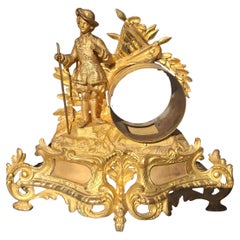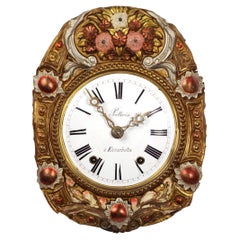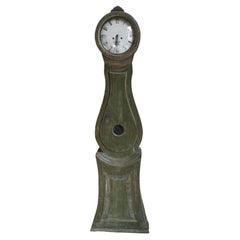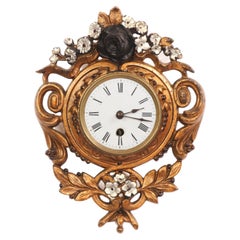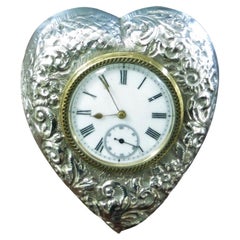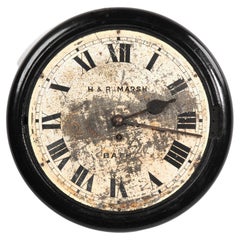Working Antique Clock
18th Century and Earlier French Louis XVI Working Antique Clock
Glass, Walnut
Early 19th Century French Louis XVI Working Antique Clock
Carrara Marble
Early 19th Century French Working Antique Clock
Bronze
Early 1800s French Louis XVI Working Antique Clock
Bronze
19th Century French Victorian Working Antique Clock
Brass, Iron
18th Century Swedish Rococo Working Antique Clock
Enamel
19th Century French Victorian Working Antique Clock
Metal
1890s English Victorian Working Antique Clock
Silver
Early 20th Century British Industrial Working Antique Clock
Brass, Steel, Iron
19th Century British Folk Art Working Antique Clock
Iron
19th Century British Industrial Working Antique Clock
Brass, Iron
19th Century English Industrial Working Antique Clock
Brass, Iron
19th Century English Industrial Working Antique Clock
Iron
19th Century British Rococo Revival Working Antique Clock
Bronze
Early 20th Century French Industrial Working Antique Clock
Aluminum, Steel
19th Century British Folk Art Working Antique Clock
Iron
Early 20th Century German Rococo Revival Working Antique Clock
Walnut
19th Century English Industrial Working Antique Clock
Iron
Early 20th Century French Industrial Working Antique Clock
Metal
Early 20th Century Unknown Industrial Working Antique Clock
Steel
Early 20th Century German Art Deco Working Antique Clock
Brass
19th Century British Folk Art Working Antique Clock
Brass, Iron
19th Century British Folk Art Working Antique Clock
Brass, Iron
19th Century English Industrial Working Antique Clock
Iron
Early 1900s British Industrial Working Antique Clock
Copper
Early 20th Century European Black Forest Working Antique Clock
Brass, Iron
19th Century Austrian Neoclassical Working Antique Clock
Alabaster
19th Century French Louis XVI Working Antique Clock
Marble, Ormolu
18th Century and Earlier British Chippendale Working Antique Clock
Late 19th Century Swiss Working Antique Clock
Wood
19th Century German Neoclassical Working Antique Clock
Bronze
Mid-19th Century French Working Antique Clock
Bronze
19th Century French Louis Philippe Working Antique Clock
Bronze
1890s French Provincial Working Antique Clock
Porcelain
Late 19th Century American Neoclassical Working Antique Clock
Wood
Early 20th Century European Jugendstil Working Antique Clock
Metal, Brass
1820s French Louis Philippe Working Antique Clock
Marble, Bronze, Enamel
Early 20th Century French Art Deco Working Antique Clock
Marble, Metal, Brass, Enamel
1840s French Louis Philippe Working Antique Clock
19th Century British Regency Working Antique Clock
Lacquer
1920s English Working Antique Clock
Walnut
Late 19th Century French Working Antique Clock
Iron
Late 19th Century French Working Antique Clock
Brass, Steel
Late 19th Century French Working Antique Clock
Iron
19th Century European Working Antique Clock
Walnut
19th Century French Working Antique Clock
Bronze
Early 20th Century American Modern Working Antique Clock
Bakelite
Early 20th Century Swiss Working Antique Clock
Wood
Early 18th Century Swedish Gustavian Working Antique Clock
Wood
Early 20th Century Belgian Working Antique Clock
Porcelain, Oak, Softwood
18th Century Swedish Gustavian Working Antique Clock
Wood
18th Century Swedish Gustavian Working Antique Clock
Wood
18th Century Swedish Gustavian Working Antique Clock
Wood
Early 1800s European Gustavian Working Antique Clock
Wood
Early 1800s Swedish Gustavian Working Antique Clock
Wood
19th Century Swedish Gustavian Working Antique Clock
Wood
19th Century Swedish Gustavian Working Antique Clock
Wood
- 1
- ...
Working Antique Clock For Sale on 1stDibs
How Much is a Working Antique Clock?
Finding the Right Clocks for You
A sophisticated clock design, whether it’s a desk clock, mantel clock or large wall clock for your living room, is a decorative object to be admired in your home as much as it is a necessary functional element. This is part of the reason clocks make such superb collectibles. Given the versatility of these treasured fixtures — they’ve long been made in a range of shapes, sizes and styles — a clock can prove integral to your own particular interior decor.
Antique and vintage clocks can whisk us back to the 18th and 19th centuries. When most people think of antique clocks, they imagine an Art Deco Bakelite tabletop clock or wall clock, named for the revolutionary synthetic plastic, Bakelite, of which they’re made, or a stately antique grandfather clock. But the art of clock-making goes way back, transcending continents and encompassing an entire range of design styles and technologies. In short, there are many kinds of clocks depending on your needs.
A variety of wall clocks can be found on 1stDibs. A large antique hand-carved walnut wall clock is best suited to a big room and a flat background given what will likely be outwardly sculptural features, while Georgian grandfather clocks, or longcase clocks, will help welcome rainswept guests into your entryway or foyer. An interactive cuckoo clock, large or small, is guaranteed to bring outsize personality to your living room or dining room. For conversation pieces of a similar breed, mid-century modern enthusiasts go for the curious Ball clock, the first of more than 150 clock models conceived in the studio of legendary architect and designer George Nelson.
Minimalist contemporary clocks and books pair nicely on a shelf, but an eye-catching vintage mantel clock can add balance to your home library while drawing attention to your art and design books and other decorative objects. Ormolu clocks dating from the Louis XVI period, designed in the neoclassical style, are often profusely ornate, featuring architectural flourishes and rich naturalistic details. Rococo-style mantel clocks of Meissen porcelain or porcelain originating from manufacturers in cities such as Limoges, France, during the 18th and 19th centuries, exude an air of imperial elegance on your shelves or side tables and can help give your desk a 19th-century upgrade.
On 1stDibs, find a range of extraordinary antique and vintage clocks today.
- How does a Congreve clock work?1 Answer1stDibs ExpertApril 5, 2022The Congreve clock is a stroke of genius. A brass ball zig-zags down a platform in a time span of 15 seconds. Once the ball reaches the end, it hits a lever and a spring pushes the platform up, which tilts the brass ball back down the zig-zag path. The hands of the clock also advance by 15 seconds. You can shop a selection of Congreve clocks on 1stDibs.
- How does a carriage clock work?1 Answer1stDibs ExpertAugust 24, 2021Carriage clocks are spring-driven clocks; the spring has to be rewound every eight days for accuracy. The distinguishing feature of a carriage clock is platform escapement. It uses balance and spring for timekeeping.
- How does a longcase clock work?1 Answer1stDibs ExpertApril 5, 2022A longcase clock works with the help of a pendulum, which is usually hidden away in the body of the clock. As the pendulum swings, it creates kinetic energy that then turns the gears to move the hands on the face. You'll find a variety of longcase clocks on 1stDibs.
- How do ball clocks work?1 Answer1stDibs ExpertApril 5, 2022A rolling ball clock works with an electric motor. Every five or 10 minutes, the top rail will deposit a ball onto the next rail to indicate what minute it is in multiples of five or 10. Every hour, the upper and middle rails reset and one ball is transferred to the bottom rail to indicate the hour. Shop a collection of vintage ball clocks on 1stDibs.
- 1stDibs ExpertApril 5, 2022How a Westminster clock works involves a quartz movement system. It provides the power needed to turn the gears, swing the pendulum and produce the chime melody. Depending on the clock's design and your preferred setting, the chimes may play on the hour, half hour or quarter hour. Find a selection of Westminster clocks on 1stDibs.
- How does a flip clock work?1 Answer1stDibs ExpertAugust 24, 2021The flip clock works on the split-flap mechanism wherein the pages or tiles are attached to a wheel. There are dedicated sections for hours and minutes for clear indication. It operates on an electric motor that moves with the help of a reduction gear train.
- 1stDibs ExpertApril 5, 2022How a Howard Miller clock works depends on the type of clock. Ones that feature pendulums harness the energy created by the swinging to drive their movements. Others feature wind-up mechanisms or use batteries for power. Shop a range of Howard Miller clocks on 1stDibs.
- Do atomic clocks really work?1 Answer1stDibs ExpertApril 5, 2022Yes, atomic clocks really work. In fact, they can be very precise timekeepers. When exposed to radiation, electrons get “excited” and move. A detector in atomic clocks keeps track of the changes in atomic energy states and when it reaches a specific level, a second is ticked off. Shop a collection of atomic clocks from some of the world’s top sellers on 1stDibs.
- 1stDibs ExpertAugust 24, 2021A Westminster chime clock uses quartz movement to work the gears, to move pendulums and to play the popular melody everyone is fond of. The quartz movement electronically plays the melody that can be set to play on the hour, half an hour and quarter hour if desired. Find a wide range of antique, new and vintage clocks on 1stDibs.
- 1stDibs ExpertAugust 24, 2021To make a mechanical alarm clock work, you need to use the wind-up keys or buttons to set the time. Mechanical alarm clocks use an oscillating wheel and springs. Most mechanical alarm clocks come with two bells that ring by means of a gear, powered by the mainspring. The gear moves quickly between the two bells, sounding the alarm. Find vintage alarm clocks on 1stDibs.
- How do antique compasses work?1 Answer1stDibs ExpertApril 5, 2022Antique compasses work with the use of magnets. Compasses use a magnetized needle that can rotate to line up with the Earth’s magnetic field, pointing towards the magnetic north. The basic concept of how compasses work has not changed over several centuries and magnetic compasses continue to work well today. Shop a variety of antique compasses on 1stDibs.
- 1stDibs ExpertApril 5, 2022The Jaeger-LeCoultre defines the Atmos as the clock that lives in the moment. The Atmos features an airtight capsule with a gaseous blend trapped inside that expands as the temperature rises and contracts when it drops. This movement changes the size of the capsule, which activates a small chain to wind the clock. Find a collection of expertly vetted Atmos clocks from some of the world’s top boutiques on 1stDibs.
- 1stDibs ExpertApril 5, 2022An antique fob watch works with the help of a winding mechanism. Turning the winder puts tension on the clockwork gears, allowing them to move. Depending on the watch, you may wind it with a specially designed key or a winding crown located on the stem of the timepiece. You'll find a collection of antique fob watches on 1stDibs.
- 1stDibs ExpertFebruary 27, 2024To identify your antique clock, search for markings on the back of its movement or case. Once you have located these marks, use trusted online resources to determine who the maker is. From there, you can continue your research to learn more about your clock's age, style and other characteristics. An expert appraiser or antiques dealer can also assist you with identification. Find a wide range of antique clocks on 1stDibs.
- 1stDibs ExpertApril 5, 2022Check the clock for a manufacturer’s mark or label. Once you have this, you should be able to look up the clock’s brand to see if it is French in origin. A clock is considered antique once it is 100 years old. A professional can also help verify the origin of your clock. Shop an array of expertly vetted antique clocks on 1stDibs.
- How can I spot an antique clock?1 Answer1stDibs ExpertApril 5, 2022To spot whether or not a clock is antique, note if the clockmaker’s name or company is engraved near the center face of the dial. A paper label may also be pasted on the back of the clock. You can shop a collection of expertly vetted antique clocks from some of the world’s top sellers on 1stDibs.
- 1stDibs ExpertOctober 26, 2021An antique bracket clock refers to a portable spring-driven pendulum table clock created in the 17th and 18th centuries. These clocks were equipped with convenient carrying handles and were housed usually in rectangular cases. Shop a collection of antique and vintage bracket clocks from some of the world’s top dealers on 1stDibs.
- 1stDibs ExpertFebruary 17, 2023To know if an antique clock is valuable, you'll typically need to have the piece assessed by a certified appraiser or an experienced antiques dealer. The maker and style of the clock will help determine its value (an early American clockmaker’s antique grandfather model, featuring an oak case and decorative carvings, may be very interesting to collectors, for example). Overall condition of your clock also plays a role. Generally, clocks that still work are worth more than those that require repairs. On 1stDibs, find a selection of antique, vintage and modern clocks.
- 1stDibs ExpertSeptember 16, 2024Yes, some old antique clocks may be worth something. Many collectors look for clocks produced by certain manufacturers, such as the Ansonia Clock Company, the Seth Thomas Clock Company, Jaeger-LeCoultre and the Chelsea Clock Company. In addition to the maker, the type, materials, style and condition of the clock influence its value. Generally, clocks that remain in good working order are worth more than those in need of repairs and restorations. To find out how much your clock may be worth, consult a certified appraiser or experienced antique dealer. On 1stDibs, explore a large collection of antique clocks.
Read More
How a Craving for Color Revolutionized Glass
After synthetic dyes changed fashion, home goods and printed matter, it was only a matter of time till glass caught up.
Kazuyo Sejima’s Flowering Tree Blooms Year-Round
The brilliantly simple design turns a modest bouquet into a major statement.
He Wrote ‘Oedipus Rex,’ but Do You Know What He Looked Like?
The Greek tragedian is said to have been handsome in his day.
Cigar Culture Was Once the Peak of Masculinity. Now, It’s a Compelling Curiosity
Even for those who don’t indulge, elegant smoking accessories and audacious art portraying cigar enthusiasts hold a nostalgic allure.
African Travel Plans on Hold? This Ardmore Leopard Vase Brings the Beauty of the Savanna to You
It’s an excellent example of the sought-after ceramics coming out of South Africa’s KwaZulu-Natal province.
With a High-Tech Flagship and Cool Collabs, Lladró Is Breaking the Mold for Porcelain Production
Thanks to its new leadership, the Spanish maker of figurines, busts and lighting is on a mission to update the art of porcelain for the 21st century.
Zoë Powell’s Magnolia 05 Vessel Is Handmade from Clay She Unearthed Herself
The free-form stoneware piece is inspired by the magnolia tree and its associations with home.
8 Ways to Breathe New Life into a Space with Plants
The pair behind the Instagram account @houseplantclub share their tips for making any room of the house gloriously green.
